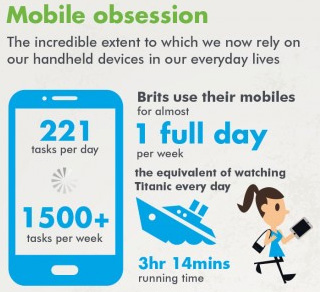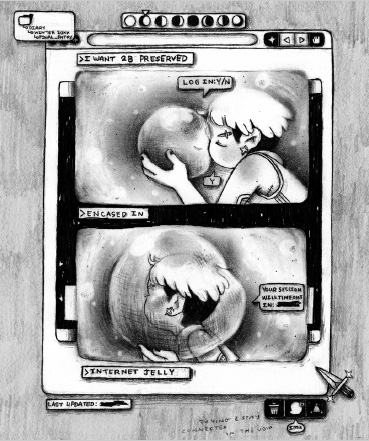Lately, I’ve been reading comics that represent the internet as a part of contemporary daily life. Frequent depictions of the internet might be something we’d expect from popular culture when being online has become so omnipresent, especially with the spread of smartphones.

Survey results from TecMark. The 3-5 hour mark seems pretty consistent over the more recent surveys I read
Yet if you consider how internet use is represented in other mediums like literature, photography or film, you might not have any idea how deeply integrated being online has become in our lives nor how emotionally engaged we are with our online interactions.
During the 1990s-2000s, we positioned online interaction as an augmentation to IRL interactions. We still drew a strict distinction between IRL and online socializing, with online interactions being viewed as inferior and possibly harmful, especially for teens (typical article from the era).
Non-comic mediums still maintain the IRL/online distinction; the internet is usually depicted as peripheral both in form and content. In regard to form, film critic, Tony Zhou, has some interesting insights into this problem. And when it comes to content, much of the non-comic works I come across don’t feature the internet in ways that reflect contemporary times. It’s like a part of your life is simply absent in art.
The only times I can recall seeing other mediums focus on being online is in science fiction, especially during the cyberpunk days: Ghost in the Shell, Serial Experiments Lain, Neuromancer. But these 90s scifi fantasies about the future bear little relation to how I use the internet today.

Major Kusanagi merges into cyberspace
What I like about the comics I’m reading is that they’re not genre comics. They’re not trying to make grand, philosophical theories about cyberspace and humanity. They are about people’s daily lives. They are not interested in an IRL/online distinction.
Consider Merritt Kopas’ Internet Murder Revenge Fantasy which is focused on how the author navigates personal emotional conflicts online (left page by Alex Degen; right page by Sophia Foster-Dimino).
Or Kelly Kwang’s charming multimedia Space Youth Cadet, which explores the development of one’s identity and social roles online using analog materials.

I can think of a couple reasons for why I’m only seeing these types of representations of the internet in comics. First, the lower barrier to entry in publishing comics means that younger cartoonists (i.e. heavier online users) are able to publish stories – and they are stories that reflect their lived realities.
But more fundamentally, the norm of using multiple panels in comics presents an advantage over other mediums when it comes to representing the internet. Multiple panels easily mimic the multiple windows and tabs of our online browsing. Split screen representations don’t feel as jarring as it might in other mediums.
Consider this page from Rebekka Dunlap’s Brooklyn Witch Tweets (from Dream Tube) which manages to make a clutter of windows on a desktop look visually interesting.

Or this page from Gina Wynbrandt’s Big Pussy which mimics the way we go back and forth between digital screens. Note how everything reads seamlessly and naturally.

I’ve also seen multiple panels succeed in representing the experience of being online. Rather than showing characters using the internet or texting, they also show us the immersive yet disembodied nature of being online. Here’s another page from Kwang’s Space Youth Cadet.

On this page, panels and icons replicate the multiple frames of digital screens while the internet itself is a blob of jelly one merges with. Here, the radical split between the physical and phenomenological realities of being online are captured in one image. (Note the Sophia Foster-Dimino image above achieves the same thing.)
In all cases, the comics image is read as holistic, allowing the differences between our physical world, our digital screens and our phenomenological experiences to be more easily collapsed and visually united in ways that I haven’t seen yet in other mediums. In this way, I feel like comics has been the only medium I’ve seen keep up with our times in representing how we use the internet and how that feels. I’m looking forward to seeing how comics keeps apace as technology continues to change!
p.s. If you know of any other comics that represent the internet in an interesting way, I’d love to hear about it.


Pingback: Comics A.M. | Maggin, Hughes, to receive Bill Finger Awards | Robot 6 | The Comics Culture Blog
Pingback: Comics A.M. - Maggin & Hughes to Receive Bill Finger Awards – IdiotBox Reviews
Pingback: Comics A.M. – Maggin & Hughes to Receive Bill Finger Awards – Mostviral